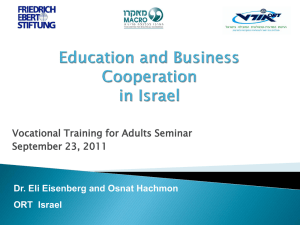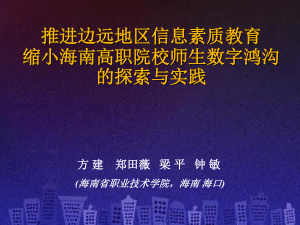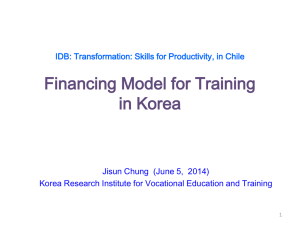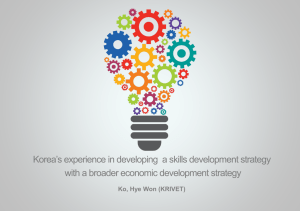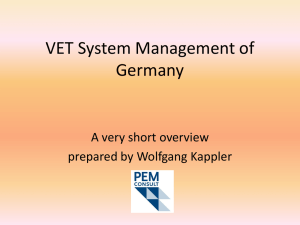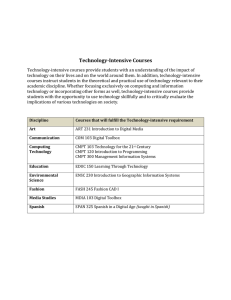Vocational Education & Training in South Korea
advertisement
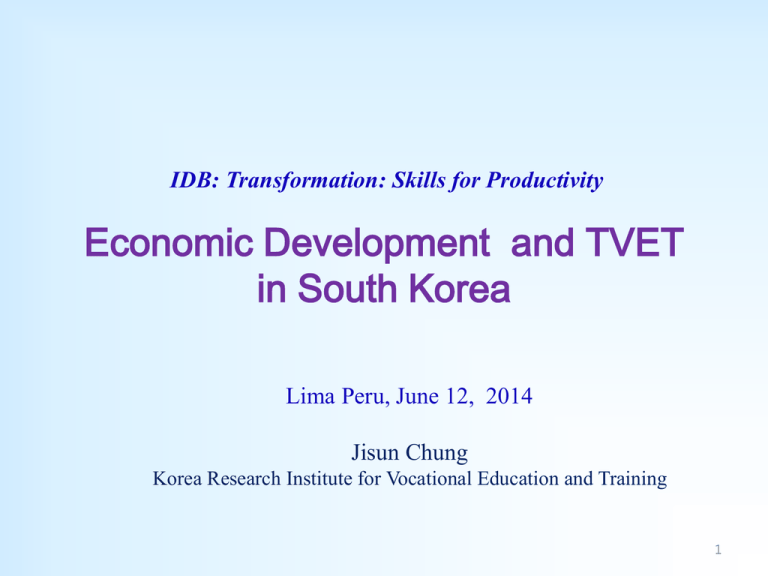
IDB: Transformation: Skills for Productivity Economic Development and TVET in South Korea Lima Peru, June 12, 2014 Jisun Chung Korea Research Institute for Vocational Education and Training 1 Changes in GDP per Capita since 1960s 26,204 26000 24000 ($) 21,529 22000 20000 18000 16000 14000 12000 11,471 10000 8000 6000 4000 2000 0 105 ‘60 ‘65 ‘70 ‘75 ‘80 ‘85 ‘90 ‘95 ‘00 ‘05 ‘10 ‘11 ‘13 ‘14 1965-1995: 100-times increase in GDP per capita only in 30 years. 2 [Success Factors of the Korean Economy] 1. Government Leadership in Economic Growth Implementing a series of “Five-year Economic Development Plans” 1st –7th : 1962 – 1996 2. Success of Private Sector The major domestic companies (Samsung, Hyundai, Kia, LG, Daewoo, POSCO .….) lead national economy 3 [Success Factors of the Korean Economy] 3. Human Resources Development <chart> Pop. attained at least upper secondary ed (2013) 100 80 60 40 25-34 year-olds 20 0 55-64 years-olds Indigenous Enthusiasm for Education and HRD dichotomy between old and new generations 4 Shift in Industries (1960s) Before 1960 ◁ Traditionally agricultural society -Government planned to shift from agriculture to manufacturing which was more value-added. (strategic industry) From 1960s ◀Industrialization ◀Manufacturing industries - general merchandise - light industries (e.g. textiles, footwear, wig) ◀ Labor Intensive exportoriented industries - with comparative advantage of cheap and abundant labor 5 Policies of Vocational Education and Training supporting Economic Development • Construction of infrastructure of vocational education Primary education for six years has been compulsory to support industrialization. Public training centers were established. Vocational Training Act in 1967 • Cultural Factors: People’s indigenous enthusiasm for education and work (Confucian culture) - diligence: work hard for family, society, and country - aspiration for upward social mobility: Skills development (education and training) was mechanism for social upward mobility. 6 1970s~1980s: Transitioned to Heavy and Chemical Industries petro-chemical, shipbuilding, automobiles, electric and electronic industries ◆Skilled workers and technicians were needed - expansion of vocational high schools, vocational colleges - Increase in in-house training system 7 1980s~1990s: Technology-intensive Industries • Shifted to technology-intensive industries – Demand for high-skilled, multi-skilled technicians – Expansion of 2-year vocational colleges, polytechnic universities, and 4-year universities – Increase in role of public training organization and qualification authorization (HRD Korea) • Employment Insurance System was established in 1995. (Social Safety Net: for the unemployed as well as employed to be trained) 8 Knowledge-based Economy In 2000s • IT, BT, NT, CT, ST, ET… knowledge intensive, more highly skilled workers were needed • Labor cost raised high with increase of national income and more educational achievement. - Low labor cost was not a comparative advantage any more : many developing countries retain lower waged labor-force • Then high skills and knowledge are more important to develop competitiveness. 9 Brief History of Skills Development Policies in Korea: Industry and Export Profile Source : Bank of Korea Key Skills Development Policies 11 Contribution of Skills Development Timely supply of skilled workforce in step with the industrial development stages has contributed to economic development. SD, heavily represented by government-led public training in the initial stage, is in transition to market-led paradigm marked by voluntary participation and government support. Labor-intensive light industries (cheap labor=comparative advantage) Technology-intensive industries (skilled labor) Knowledge Industry (High-skills/ High-tech) Labor-intensive Technology Knowledge-based 90 70 50 30 10 -10 1970 1975 Primary 1980 1990 1995 Lower Secondary 2000 2003 Upper Secondary 2010 2012 Tertiary 12 Muchas Gracias! 13


